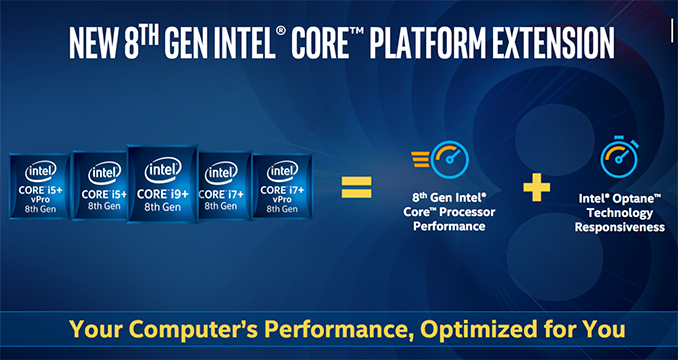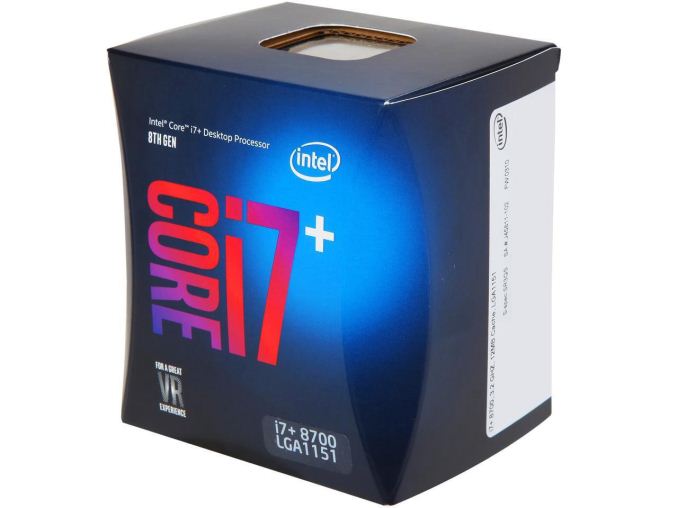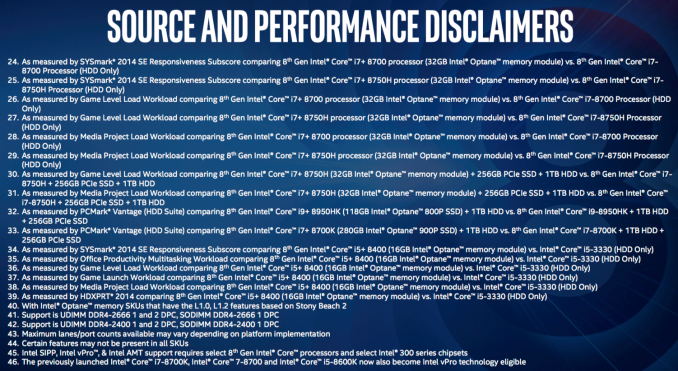Intel’s Core i5+, Core i7+ CPUs with Bundled Optane Memory Hit Retail
by Anton Shilov on April 12, 2018 5:30 PM EST
Earlier this month Intel introduced its Core i+ processor brand for desktops and laptops. The brand-within-a-brand setup sees Intel's 8th gen Core i5, i7, and i9 CPUs bundled with its Optane caching SSDs (aka Optane Memory) and sold as the i5+, i7+, and i9+ respectively. The chip giant aims such CPUs at customers who would like to improve performance of their storage subsystems yet won't be investing in full-fledged SSDs. And, after showing up in OEM systems with last week's launch, the Core i+ processors are now also to retail buyers.
Overall, Intel is rolling out the Core i+ in retail, targeting DIY end-users in the U.S., Canada, and Japan. The lineup of Intel’s Core+ CPUs for desktops currently consists of three SKUs: the Core i7+8700, the Core i5+8500 and the Core i5+8400. The bundles include 16 GB Optane caching drives and are priced at $340, $240 and $215, respectively. For mobile computers, Intel is also offering Core i9+ processor bundles, but it remains to be seen whether the company also plans to expand the family of its Optane-bundled offerings for desktops.
| Intel Core i5+ and Core i7+ CPUs with Bundled Optane Memory for Desktops | |||||
| Price with 16 GB Optane | Price of CPU only | PN | |||
| Core i7+8700 | $340 | $302 | BO80684I78700 | ||
| Core i5+8500 | $240 | $205 | BO80684I58500 | ||
| Core i5+8400 | $215 | $179 | BO80684I58400 | ||
With its Optane Memory products, Intel is attempting to kill two birds with one stone. Firstly, the company is capitalizing on demand for high-performance/high-capacity storage subsystems that combine responsiveness of SSDs and capacities of HDDs. Secondly, the company is ramping up production of its 3D XPoint memory and gaining experience in its high-volume manufacturing (i.e., improving yields), something that it is going to need to address needs of datacenter and enterprise market segments going forward.
This increased focus on selling lower capacity Optane modules for caching comes as Intel has made some notable changes to their caching subsystem to improve its usefulness. The Optane software can now cache data from any HDD (not just the primary/boot one), opening up interesting usage scenarios with secondary HDDs for end-users who have already invested in a SSD for their boot drive.
Intel says that a hybrid storage subsystem accelerated by a 32 GB Optane caching SSD is 1.7 – 3.9 times faster when compared to a non-accelerated HDD-based subsystem (see the slides below for details). The performance boost only occurs in situations when cached data is used, so a caching SSD is not a replacement for a regular SSD. However, it is considerably cheaper and since it does improve user experience, it makes the Core i+ bundles particularly useful for PC makers.
Last year Intel teamed up with select makers of motherboards to bundle its Optane caching SSDs with their platforms. This year the company is shifting its strategy and intends to sell such drives with its CPUs.
Related Reading:
- The Intel Optane Memory (SSD) Preview: 32GB of Kaby Lake Caching
- The Intel Optane SSD 800p (58GB & 118GB) Review: Almost The Right Size
- The Intel Optane SSD 900p 480GB Review: Diving Deeper Into 3D XPoint
Sources: TechReport, Tom’s Hardware













42 Comments
View All Comments
Phyzzi - Friday, April 13, 2018 - link
Thank you!Even in the world of SSD's there are fast ones and slow ones, and this is decidely fast.
It's also a nice intermediate to a full system on a chip, taken with other developments like the the high end GPU integration that they are doing with AMD. This chip may seem like the target audience is limited, but if the next step is a package with 64 or 128 GB ssd, integrated ram and a high end gpu, all on a single chip, every ultralight laptop maker in the world will want that.
Native7i - Friday, April 13, 2018 - link
Yes. For gamesPeachNCream - Monday, April 16, 2018 - link
I have a 1TB 5400RPM hard drive in one of my laptops because I needed the storage space and didn't want to tote around an external drive. It runs Linux so it's not as painful as Windows on boot up or when loading programs, but I am thinking about picking up a similar size SSD. Then again, it's a seven year old laptop so I'm loathe to throw money at storage far in excess of the computer's current value.emvonline - Monday, April 16, 2018 - link
@p1esk: most pcs (desktop + notebook) sold in 2018 come with HDD. >2/3 PCs in use have only HDDwumpus - Monday, April 16, 2018 - link
Traditionally, there was a saying "the steady state of a hard drive is full". These days, plenty of people simply don't fill up more than 100G of space (obviously neither gamers nor other heavy computer users), and thus don't need rotating rust. For everybody else, $50-70 for a few terabytes is a godsend, and simply a required item in any build.Of course, once you start collecting a few of these there is the obvious question of leaving them in your PC or adding a NAS. Single users (or only heavy user in a family) can obviously get away with leaving them in a PC, but others will want the NAS (if only for media storage).
There's also the issue of windows occasionally simply *has* to spin every drive it has. That is annoying. I don't think I've seen this in Linux even though Linus has been quoted in the "all rotating rust belongs in a NAS" camp (the actual quote was more about "PCs should be all SSD").
Personally, I'd be much more interested in AMD's 470 board and simply using a chunk of a SSD. If Intel is serious about doing this with optane, they need to imbed the stuff in the motherboard/south bridge and cache SSDs. Very few people who are willing to pay for 16G of cache want it on their HDD.
crimson117 - Friday, April 13, 2018 - link
Are all those performance numbers in comparison to a purely traditional HDD setup?If so, that's kind of worthless...
PeachNCream - Friday, April 13, 2018 - link
I'm not really very interested in Optane as a drive cache at this point. Using any SSD, even a budget TLC drive, will give the person at the keyboard a system that's responsive enough. What I see in Optane's future are the benefits of superior endurance versus NAND so it or some later iteration of it can replace current solid state storage and integration with RAM on DIMMs for lower power operation, saving current system states, or just pairing up storage with system memory for tighter integration and smaller system. Those are exciting and interesting. Using Optane as a way to compensate for being stuck on a mechanical hard drive (I get it, there are some situations where the capacity is a necessity and the speed isn't as big of a factor) feels oddly similar to how Windows Vista's ReadyBoost was a poor alternative to getting more RAM for your computer.Lolimaster - Saturday, April 14, 2018 - link
It's actually better to use the small optane as pagefile rather than a "boost".Hixbot - Saturday, April 14, 2018 - link
Any chance anandtech editors can review the "from the web" clickbait at the bottom of every article. Many have inappropriate images for the workplace.Ryan Smith - Monday, April 16, 2018 - link
Hey Hixbot.The RevContent ads are approved by our publisher's advertising group. So I don't have direct editorial control over them. But all the same I appreciate the feedback and I will pass along your comments to the group.